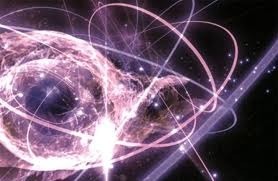TOP 10 DEVELOPMENTS IN FRINGE-OLOGY: 7
 FASTER THAN LIGHT: SURGING TOWARD (THE NEED FOR) A NEW PHYSICS?
FASTER THAN LIGHT: SURGING TOWARD (THE NEED FOR) A NEW PHYSICS?
We'll make this quick.
Dark matter is still mysterious. In fact, it is probably more mysterious than ever. This New Scientist article explains the problem. A dark matter experiment called CoGeNT seemed on the verge of triumph, turning up possible sightings of the invisible stuff scientists believe makes up roughly 85-percent of the Universe. Then everything went, well, in admittedly unscientific terms, higgledy-piggledy. The dark matter scientists thought they were glimpsing is proving wildly inconsistent, appearing to be different things in different detectors, heavier in some detectors and lighter in others.
From New Scientist:
In the most extreme case, it shows up in one instrument but not in another—even when both are made of identical material and are sitting virtually next door in the same underground lab.
"The present situation is pretty confusing," admits Juan Collar of the University of Chicago, who is head of the CoGeNT dark matter experiment, based in the Soudan Underground Laboratory in Minnesota. It is seeing something – hundreds of somethings – each of which could be a dark matter particle striking the detector. But if CoGeNT and the other experiments are truly seeing dark matter, then it's not what anybody thought it was.
Moving on, researchers in Italy have conducted a pair of experiments they say proves the impossible: neutrinos travel faster than light, violating general relativity. The experiment itself is super-cool, sending neutrinos through the ground from Cern, near Geneva, to the Gran Sasso lab, in Italy, 450 miles away.
The results, however, qualify as an "extraordinary claim"—the theory of relativity has served us pretty well, after all—so this dispute figures to drag on for a while. (Indeed, physicists at Washington University argue that a systematic measurement error is to blame.)
Perhaps most importantly, the Higgs-Boson, predicted by the standard model of physics, and believed to confer mass to quarks, electrons and the other fundamental building blocks of our physical world, is proving elusive. And so I turn you over to novelist and physicist Alan Lightman, whose recent, brilliant Harper's article muses:
*
"The history of science can be viewed as the recasting of phenomena that were once thought to be accidents as phenomena that can be understood in terms of fundamental causes and principles. One can add to the list of the fully explained: the hue of the sky, the orbits of planets, the angle of the wake of a boat moving through a lake, the six-sided patterns of snowflakes, the weight of a flying bustard, the temperature of boiling water, the size of raindrops, the circular shape of the sun. All these phenomena and many more, once thought to have been fixed at the beginning of time or to be the result of random events thereafter, have been explained as necessary consequences of the fundamental laws of nature—laws discovered by human beings.
"This long and appealing trend may be coming to an end. Dramatic developments in cosmological findings and thought have led some of the world's premier physicists to propose that our universe is only one of an enormous number of universes with wildly varying properties, and that some of the most basic features of our particular universe are indeed mere accidents—a random throw of the cosmic dice. In which case, there is no hope of ever explaining our universe's features in terms of fundamental causes and principles."
*
The upshot of all this, as I see it, is that science may be leading us toward an incredible truth: That the Universe is unknowable, or at least not knowable in the way we've traditionally thought or hoped.
In Fringe-ology, I address some of the current debates in physics—including the Many Worlds hypothesis and Roger Penrose's prediction that the mystery of consciousness will only be unraveled through a new physics. But, as a reporter, all I can do is wait for the jury to come in.
The wait, however, sure is entertaining.
Physics seems to encourage, if not outright require, some of the most outlandish claims in all of science. Luc Montagnier, the joint winner of the 2008 Nobel Prize for medicine, is claiming that DNA can send electromagnetic imprints of itself into distant cells and fluids, which can then be used to create copies of the original DNA. If true, this finding would thrust quantum mechanics firmly into the realm of biology.
The results of Montagnier's experiment seem far-fetched. But multiple research teams are finding evidence for quantum effects at the level of DNA (see here and here.
Biological systems are simply thought to be too warm, wet and noisy to sustain meaningful quantum effects, which are thought to require cold, stable environments to exist. But as I also wrote about in Fringe-ology, evidence does keep turning up to suggest the presence of significant quantum actions in biological systems. There is not yet evidence so unequivocal as to force acceptance. But something strange does seem to be happening in science's most fundamental field. With the passage of time the amount of mystery present in physics isn't decreasing—it's growing.
Steve Volk's Blog
- Steve Volk's profile
- 18 followers



